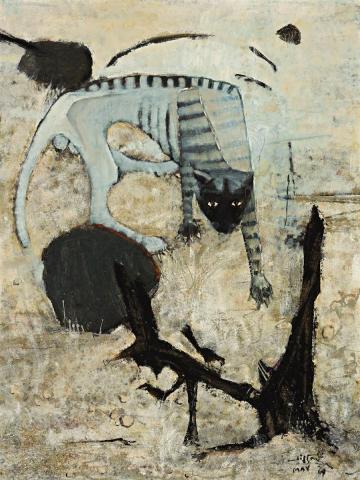A FERAL CAT, 1969
CLIFTON PUGH
oil on composition board
121.0 x 90.0 cm
signed and dated lower right: Clifton / MAY '69
inscribed verso: A FERAL CAT I
The Blue Boy Gallery, Melbourne
Private collection, Queensland
Sotheby's, Sydney, 22 August 2008, lot 70
Private collection, Queensland
Allen, T., Clifton Pugh: Patterns of a Lifetime, Thomas Nelson, Melbourne, 1981, p. 58
Clifton Pugh has long been considered one of Australia's leading painters. His broad appeal has spanned decades and his contribution to Australian portraiture was outstanding, as his three Archibald Prize winning portraits attest.
As the bipartisan court painter to Canberra's colourful political class through the 1960s and 1970s, Pugh's political portraits are legendary and live large in the collective psyche of many Australians. His celebrated 1972 Archibald Prize winning portrait of Gough Whitlam is arguably one of the finest portraits ever painted in Australia, closely followed by his portraits of Lionel Murphy QC, Sir John 'Black Jack' McEwen, H.C.' Nugget' Coombs and Sir John Kerr.
Apart from art, politics and women, Pugh's other great love was the environment. Clifton Pugh was an early and passionate environmentalist, and his understanding of the landscape and his love of nature underpins most of his work. It is in the landscape that Pugh's work reaches lyrical heights, whether it be the drought-ravished outback or the lush bush surrounds of his home at Dunmoochin, then on the outskirts of Melbourne.
Pugh's landscapes have a structural unity that ties the various elements together; there is a harmony between the subject and the ground, something that he also used to great effect in his many portraits. He was a master of all mediums and was incredibly adept at combining almost any medium; enamel house paint being a favourite he used often as it created a glassy ground on which the artist could manipulate oil paint to great visual effect. The end results of this combination would leave the work feeling fresh, spontaneous and bristling with nuanced detail.
Like the other wildlife around the Dunmoochin compound, the feral cats became a subject for his art. In this series of paintings he presents the feral cat as a reckless invader, a perfectly camouflaged and adept intruder oblivious to the native bush's delicate balance.
In A Feral Cat, 1969, the feral cat is the victim. Hungry and thin following a season of drought and fire, the cat's staple diet of small marsupials and lizards has all but gone. Now this big tom is forced to work harder for survival as he stalks his prey, fully aware that his next twitch will trigger the bird's flight to safety. The cat is frozen, so near and yet so far from a meal and survival. Pugh chooses to depict the cat's form as an echo of the surrounding landscape, and in this way he stresses the cat's vulnerability - for it too may soon be absorbed into the landscape.
Pugh never revealed the possibility of metaphor in his feral cat pictures, but it is plausible given his strident views and political associations that there was a political undertone to these particular works. As Pugh's biographer Traudi Allen noted in 1981:
'To Pugh a strong element of discord exists in the fact that Australia is inhabited at all ... The Australian bush has until now been a cyclical entity in which minor changes occur constantly but harmoniously and interdependently. Nothing is totally destroyed and nothing foreign is allowed in. Now white technology has entered its borders ... through roads, cities, agricultural and mining activities ... whereas the black man has lived in the same country for centuries leaving only a few peaceful footprints. White Australians have always been foreigners who struggle against a hard land instead of working in harmony with it as the blacks have done.'1
Pugh loved life and delighted in nature, and at times his compassion even extended to the feral cat.
1. Allen, T., Clifton Pugh: Patterns of a Lifetime, Thomas Nelson Australia, Melbourne, 1981, pp. 62-63
HENRY MULHOLLAND
